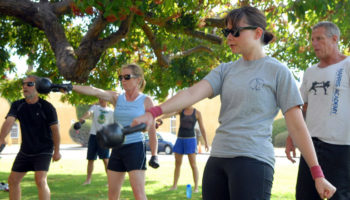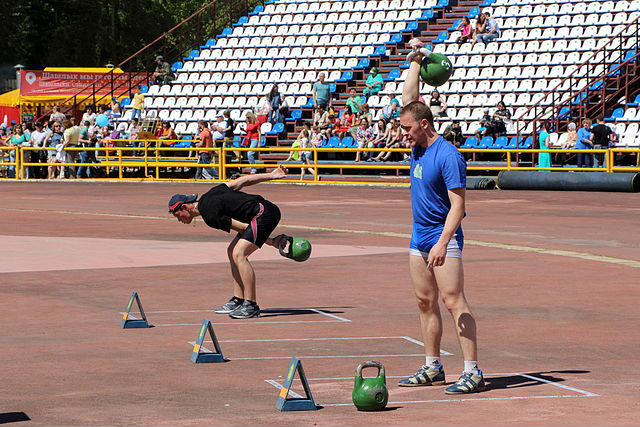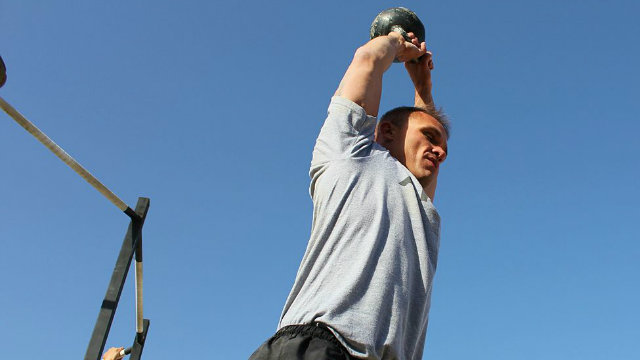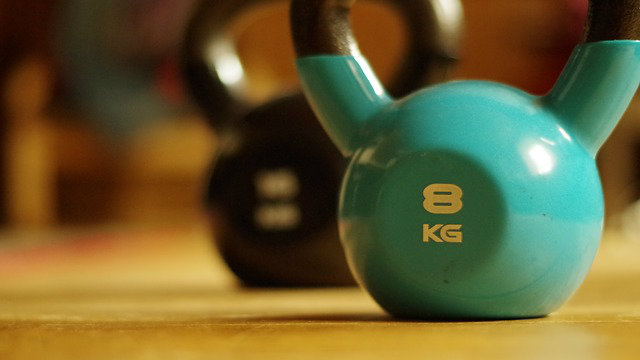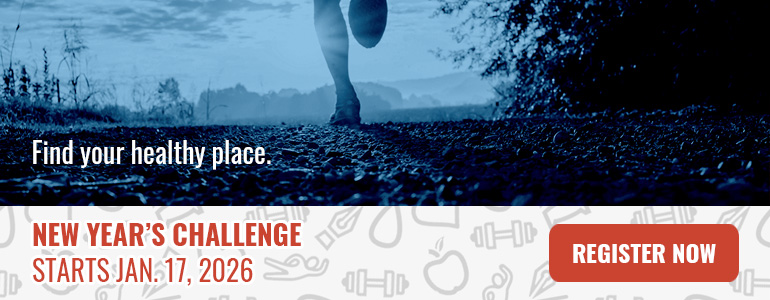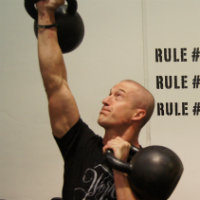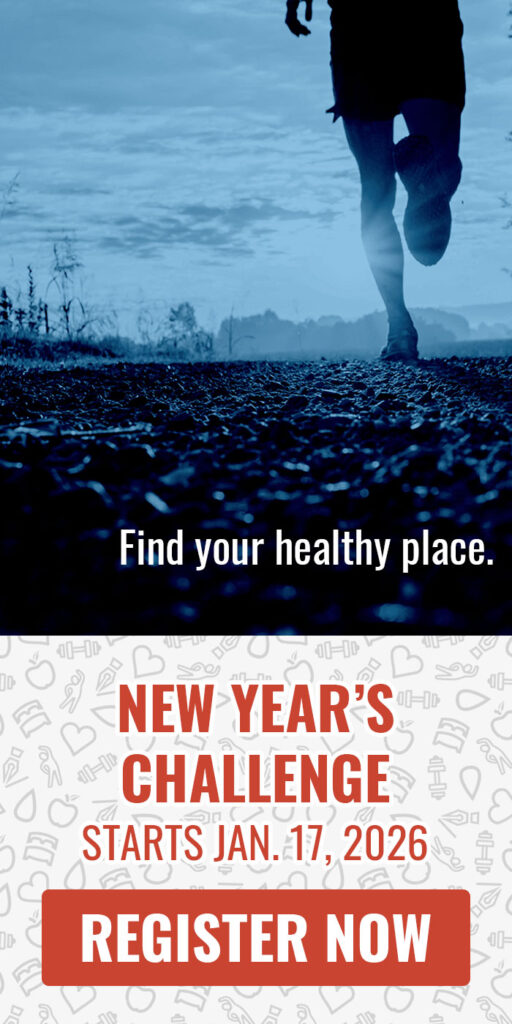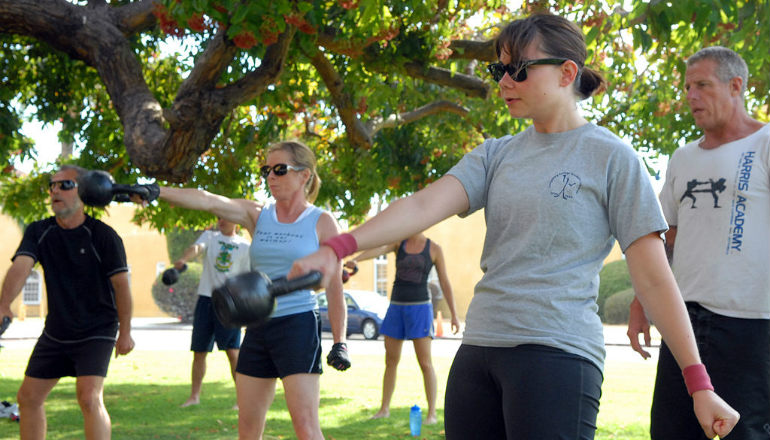 Reading Time: 5 minutes
Reading Time: 5 minutesThere are a number of pathways open to people looking to begin kettlebell training:
- Option A is with swings during a CrossFit workout.
- Option B is by training with an RKC- or StrongFirst-certified instructor.
- Option C is via corrective exercise work through systems such as the FMS with exercises like the get-up.
- Option D is through girevoy sport, which is the sport of kettlebell lifting.
Like with anything, the most important thing is to begin. While all these approaches have good points and bad points, the most important thing is to choose the path that fits your training the best, not the training path that someone is trying to sell you.
Beginning With Girevoy Sport
For many, Option D is unlikely. As a full-blown sport, girevoy sport (also known as kettlebell sport) is akin to moving from doing some weightlifting in a WOD to focusing only on the sport of weightlifting. The reason this is unappealing to most is simple – many people don’t want to focus solely on a couple of movements with a single tool and prefer the variety available with the other kettlebell training options.
Beginning With CrossFit
Option A is…well, Option A is fraught with problems. If you’re coming to kettlebells via a CrossFit gym, then you’re likely practicing the American Swing. The American Swing has a lot of issues associated with it. But don’t take my word for it, here’s what Gray Cook, creator of the Functional Movement Screen, had to say in his DVD Essentials of Coaching and Training Functional Continuums:
I’ve read the paperwork and supposedly it’s better to swing overhead than to chest-level because you have a greater range of motion, greater work capacity and greater caloric expenditure. You actually dump power when you swing overhead. If the whole point is to generate force, give me somebody who knows how to do a hard-style swing and they’ll put more force onto a force plate with a technically correct kettlebell swing to chest-level. If it’s about generating force, so you can burn calories, so you can protect your back, so you can strike a golf ball, then keep the integrity up.
If you happen to have a force plate, you will see traditional beats overhead swings every day of the week. I can put more power into the floor with less risk, less range of motion and greater safety…
This is not my opinion. We looked at it in a biomechanics lab. We didn’t hedge the bet. Less range of motion on power activities is a safer play. More range of motion on power activities and you’d better be the expert.
So let’s just say Option A isn’t such a great way forward unless you have an aim to compete in CrossFit competitions.
Beginning With RKC or StrongFirst Methods
That leaves us with Options B and C – training with an RKC/SFG or using a system like the FMS. Working with an RKC/SFG instructor isn’t the best way forward for many people. The usual starting point for kettlebell work is with the (hardstyle) swing and the get-up. While the technical understanding possessed by an RKC/SFG qualified instructor is far beyond most other trainers, there are still flaws in this approach.
Being able to perform the swing requires adequate hip mobility as well as the ability to effectively brace the spine. The get-up has so many moving parts that you could say if you can do a get-up well, then you’ll likely do many other tasks well, too. But the combination of hours sitting at work and poor training choices usually has people unable to move without restrictions when they first begin training with kettlebells. This makes the swing and get-up a step too far for many beginner trainees.
The FMS Path to Begin Kettlebell Training
That leaves Option C as the only viable choice in a smart trainer or trainee’s arsenal. Option C involves undergoing an FMS movement screen prior to beginning training. The clear advantage here is that exercises with kettlebells in this pathway range from static drills designed to enhance flexibility and motor learning to the sort of strength and conditioning exercises associated with regular kettlebell training. In other words, it is the best of both worlds.
When it comes to selecting starting weights, I’ve seen many recommendations that border on the ridiculous. In truth, females will likely need to begin with 8kg, 12kg, and 16kg bells. Males will need 12kg, 16kg, and 20kg. I know many will recommend slightly higher bells to begin with, but once you start following the pathway of Option C – of getting the body moving well before worrying about adding load – you’ll see that many of the exercises force you to use lighter loads as they’re simply more difficult.
Another advantage of Option C is that the exercise choice is extremely varied. Looking at the RKC, which has six basic exercises, you’d be forgiven for thinking that the human body is designed to do much more than just six things. If you delve deeper into the kettlebell world, you’ll often find reference to the book Simple & Sinister, which further reduces the options to two exercises. But the human body has evolved to do far more than just two things. Following the FMS pathway gives you over 400 exercises to choose from, while still addressing your individual weaknesses, as well as improving performance.
How to Make a Successful Start With Kettlebells
The basic recommendation for beginning kettlebell work is not to go purchase kettlebells then, but to find an FMS certified instructor to help you with whatever movement preparation you need. Once you’ve been screened, you can either continue working with the instructor or plug your own results into the FMS 360 software and have access to a nearly unlimited and individualized training plan that will get you ready to work hard, while reducing your risk of injury.
Once you have achieved full control of your body, then you’ll be primed to go and begin with an RKC/SFG, start working towards CrossFit competitions, or begin your journey towards girevoy sport. But don’t begin with performance methods. Begin with performance testing and make sure you are safe to deal with the demands of harder training.
